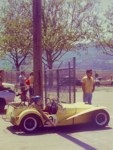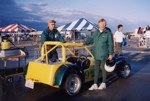|
Pat Kelley's 1960 Lotus Seven
SB1090
California, USA
I had been going through British cars at a pretty good rate, starting with the traditional MG-TD, graduating to an MGA (1958), and then to a big 1960 3L Healey. I had a lot of fun with the Healey, even building a barn storming engine at the time, with the great assistance of Walt Petersen in Livermore, CA. I was mostly interested in autocross as a safe way to have fun, and the Healey was satisfying in that regard, even when the 289 Cobras came along. I had considered buying a 289 Cobra, but it meant, because of its expense, it would be the only car I'd have -- not very practical. I was envious of the Lotus Super 7s which were prepared by Walt for road racing, but it never occurred to me to own such a small, and again impractical, car.

Photo taken about 1966, lined up for an autocross, on original 3.5 inch rims and narrow rear wings.
One day in the spring of 1965, Walt told me of a Seven America that was available at a fire sale price. He told me that the car was the woman's version of the Seven! Its owner, Jerry Demele needed some money to pay taxes, and unfortunately for him, it had to sell quickly. Jerry didn't really believe a woman wanted one, and it took some convincing that this was a very real sale, especially after he gave me a ride around the block in it.
The Seven was stunning compared to the Healey. The purchase of this little car meant I could keep the Healey (which I used to flat-tow the 7 for a period of time!) and still have fun with the Seven. Walt didn't realize just how well Jerry had set the car up, and cooked up some crazy stories to explain to customers why this car was as fast as Super Sevens, at least on a short course. I even tried road racing it; after all, Jerry had a very successful road racing career in it, I think placing as high as fourth in F Production at one of those USRRC Riverside races, though I don't have any documentation. I saw him in a race at Laguna Seca, and was impressed there was finally a British four-banger that could challenge the Porsche Speedster's dominance.
I tried road racing (6 races), best finish was 4th. The car always finished a 30 minute race, but always just barely. Something was always going wrong at the end, and I'd have to nurse her home. Autocrossing is where the car really shines, small, agile, highly maneuverable. AND, you don't have to worry about being hit by something bigger. :) A comforting thought. And we always know it'll most likely finish.
John and I were wed in 1967 and some teased him he married me for the 7A. I still road raced the car, but once I was pregnant with our first child, Katie, that stopped. However, we both continued to autocross it. Over the years the Seven has brought us much pleasure and four national championships for me (in a Ladies class), and three for John. Katie, when she was 16, won her first national championship in the same car.
I have used the Seven continuously, except for a 4-year rebuild period ending about 3 years ago. The whole under part of the frame was rusted, and we couldn't figure out why we couldn't shift the gears! We thought the tranny was broken, not realizing the frame was so rusted and collapsing that the tranny was sagging -- not in a straight line, making shifts impossible.
The car had been so good for so long, we just didn't realize in what bad shape it was in. It was looking a little shabby, and I wanted to re-skin it, so I approached Paul Traver of S&T Racing. He had made us a new bonnet when ours flew off into a corn field one year, and had demonstrated huge levels of knowledge over the years, Paul said, yes, he could supply a new skin.

John and Pat taken in 2000, in Topeka Kansas.
When he removed the aluminum skin, it was sort of like taking the girdle off a fat lady, the whole car just sagged... The frame actually rusted out, and we didn't realize it. So he had a much bigger job than either he or I imagined. He carefully took measurements, plotted the whole thing, and replaced all the rusty pieces. All the upper pieces, including those with the pertinent numbers remained, but most of the lower pieces were replaced using the same spec tubing as before. In the process of rebuilding it, we strengthened the chassis, adding a brace in the engine compartment and the side, plus, of course, the 'cage' with clever downtubes so the chassis is no longer a flexible flyer. Thus, when we adjust the shocks, we can easily shift weight from one corner to another. Paul also added some new supports for the tranny, so it's not just as it was originally. Everything he did was to make the car out-live both of us. Ironically, he did re-use the original skin when putting the car back together. Other breaking spots early on, were the right front corner and Walt Petersen welded in a strap to strengthen that. And of course, with the Goodyear slicks, the poor TR10 rear end needed straps welded all over the place. It's no longer "stock," but built to compete, with a lot of component changes, but still legal within SCCA's rules.
The Seven has always used the 948cc Sprite engine, different blocks, of course and now with billet crank. That comes with hard use!

Pat behind the wheel, splitting the cones - small photo only.
All in all, the car only gained 40 pounds from the when I bought it at 960 pounds, so now it weighs 1008# with a full tank of gas. Another thing Paul did at an earlier time was replace the gas tank with a 2-gal very clever tank that will not slosh. We only need 2 gallons at an event, and this was an easy way to cut some weight.
I read and enjoyed Dean Watts' memories of his Super Seven. Dean and his then-wife LaVerna and I went over to the local drag races one day, LaVerna bringing along the station wagon and trailer as a mother ship, fearful something was going to break. I led on the road (slowest car first, right?), followed by Dean. I got to an intersection, and Dean wasn't there! So I went on to the drag strip and waited. Sure enough, along comes Dean & LaVerna with the S7 on the trailer. He had run out of gas! :) We went off in the same class (the 2 cars looked alike, right?), and of course Dean won, but I was less than 3/4 a car length back at the end of the quarter mile. He kept looking back, "Why are you still there?" The car turned a 15.2 and 82mph, which was about as fast as it would go, except at Laguna Seca between the old turns 2 & 3, downhill, we figured it hit 88 mph, fenders flapping.
In about 1980, we named the Seven "Li'l Stroker" because it became the first car to have an engine tear down under a protest at the National Championships. There were so many rumors floating around about how we were cheating, including stroking, that someone finally bit, and we pocketed the tear down fee quite happily. The car was totally legal. As a side bit on that, we discovered a piston was tapping a valve and would have caused a major meltdown if run much longer, so the tear down was a good thing.
Since then, as younger drivers populated the class who don't understand the Seven America, the car was reclassified to run against the A Prepared level cars, including Super Sevens, Elans, Europas, Cobras and such. John just missed winning even there. We have been moved back to D Prepared, but with a huge weight penalty of 330# (weighing in at 1200#), which pretty much stops the car, sadly, if there is any hint of a hill or grade.

John is the driver in this photo - small photo only
Over the years, the rules allow us to change some components, like the tranny, rear end, things that break a lot. We have sort of gone overboard, and put in a Ford T5 5-speed hooked up to a Mazda RX3 limited slip rear. That happened after the frame cracked, and we had to rebuild it anyway, so we did the upgrades to make life simpler. We had stopped enjoying patching up the old TR10 rear end, and dealing with the Sprite gearbox. So we gained some weight and a cage in the process, but the car still works like it should.
I originally tried driving my 7 on the street, but getting to the good roads involved using freeways, where no one knew I was there! It got kind of scary... We have all the 'basic' good stuff, trannies, rear ends (note the plurals), and can put the car back to original. But not right now. :) We trailer it wherever we go, and get lots of thumbs up! Wheel size: we were using 13x7 inch rims with Goodyear slicks, not exactly what Chapman had available in 1960. We are presently on 13x6, will go back to 13x7 next year. They are Keizer wheels. Using the RX3 rear makes it so we have to use a tremendous offset on the wheels to stay within the legal track.
Both my hubby and I still autocross it. Wish we could reconstruct ourselves like we did Li'l Stroker. :)
|




